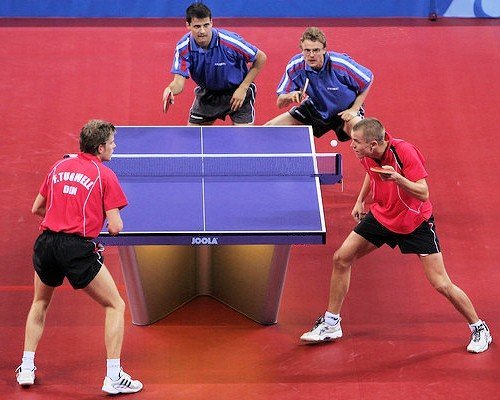Country Profile: Australian Table Tennis

Australian Table Tennis in the 1980's and beyond
From Australia's peak in the 1979 World Championship, where the men achieved a ranking of 12 in the world and the women were number 25, the 1980's saw the Australian men slowly slide down the ladder as their competitors in Europe and Asia became increasingly professional in their approach to table tennis. Australia's women have fought hard during this period, and with the help of some Chinese imports along the way, have managed to maintain a relatively steady ranking in the 20-30 bracket.
1981 in Novi Sad saw the men's team fall to number 16, while the women were ranked at number 29. This was Paul Pinkewich's last worlds after being a stalwart of the team during the 1970's.
The next Worlds were in Tokyo, Japan in 1983. Gary Haberl was introduced to the men's team, which fell further down the ladder to 24 in the world, while our women held their position at 29 with the help of Nadia Bisiach.
In 1985 the World Championships were in Gothenberg, Sweden. This was the first time in some years that the women's team outranked the men's team, 23 to 28. It also marked the last Worlds for Bob Tuckett, a member of the team from the golden era of Australia table tennis in 1979.
1987, New Delhi, India, brought the first Worlds for women's team member Kerri Tepper, who was to become a backbone of the team in years to come. It also saw the return of Paul Pinkewich who, together with Swedish import Tommy Danielsson and Gary Haberl, helped lift the mens team back to 19 in the world. The women meanwhile slipped down to 28th place.
1989 was the year Sweden broke the dominance of China in the men's events in Dortmund, Germany. Along with veteran Glenn Tepper, Australia blooded some new talent in the men's team with the introduction of Dennis Makaling and Eddie Kasser. The men's team slid back to 31 in the world, while our women's team kept up the status quo, falling one place to 29.
Chiba City, Japan was the scene for the 1991 Worlds. Our mens team brought in some more newcomers, with Jamie Perry and Peng Huy Quach making their debuts, and holding the team at a ranking of 31. In the women's teams, selectors oversaw the introduction of two new Chinese imports in Catherine Ying Kwok and Gina Hui, who along with Kerri Tepper helped the women climb up to 25 in the world.
1993 saw the retun of the Worlds to Gothenberg in Sweden. Australia continued with its policy of blooding new men's team members, this time bringing in Brett Clarke, Paul Langley, and Kent Jamieson to combine with Dennis Makaling and Jamie Perry. This didn't help Australia keep up with the world though, and the men's team fell to a low of 39. The women's team, without Kerri Tepper for the first time since 1985, but bringing in Shirley Zhou as a replacement, managed a creditable 24th.
China hosted the 1995 Worlds for the first time in many years, in the city of Tianjin. Australia's women's team once again outshone our men, finishing 23rd in the world thanks to the efforts of Shirley Zhou, Catherine Ying Kwok and the returning Kerri Tepper. Our men's team dropped further to 49th, as Russell Lavale made his world championship debut, and Dennis Makaling played his fourth and final Worlds.
1997 found the Worlds in Manchester, England, as the Australians returned to the mother country. In the women's ranks, Australia brought in three new talents, these being Yvonne Li, Miao Miao, and Tammy Gough. Along with Shirley Zhou the women fought their way into 25th place. The men's team also continued with it's policy of youth, adding Mark Smythe, Trevor Brown and Simon Gerada to the existing team members of Russell Lavale and Paul Langley. This relatively young squad managed to lift Australia's ranking to 39 in the world.
Eindhoven in the Netherlands hosted the 1999 World Championships for individual events only. The Australian team managed some creditable efforts, with Brett Clarke reaching the round of 128 in the men's singles, while Miao Miao managed to do the same in the women's singles and Shirley Zhou went one round better to get to the last 64 in the women's singles.
Kuala Lumpur in Malaysia was the location for the 2000 World Teams Championships, and this time around found our women's team of Shirley and Stella Zhou, as well as Miao Miao and Jian Fang Lay-Hong, come in at position 21-24 according to the ITTF website. Our men's team of Trevor Brown, Brett Clarke and Simon Gerada slipped a bit further down to 45 in the world.
Back to the individual events in Osaka, Japan for 2001. The women's team, absent a Zhou for the first time since 1991, brought in a few new faces as well as bringing back some other ones, as May Cho and Peri Campbell-Innes had their first taste of the World Championships, and Tammy Gough made her return along with Miao Miao, who made it to the last 64 in the women's singles. The men's team also included some fresh players, with William Henzell, John Tawadrous and Alexander Swanson making their debuts.
The 2002 World Teams was cancelled due to the troubles in Bosnia, and the inability to get a suitable last minute replacement host, so there was no action in 2002.
2003 saw the individual events take place in Paris, France. Australia's best results came from Tammy Gough, who managed to make the last 128 in the women's singles, and with her partner, May Cho, the last 64 in the women's doubles. Other Australians making the trip to France included William Henzell, Trevor Brown, John Tawadrous, and David Zalcberg in the men's, while Peri Campbell-Innes rounded out the women.